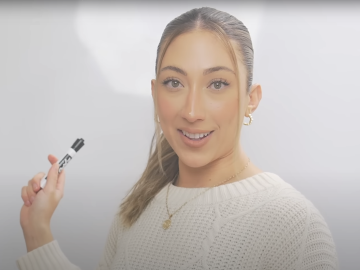Options trading is one of the most lucrative ways to make money in the stock market. Options trades done right can substantially grow your portfolio even if you have a small concentration of options positions. Like any investment, options have risks, but knowing how to make money with options trading can help you minimize risk and increase your probability of making winning trades — and we’re here to help bring you up to speed on the dos and don’ts.
Call and Put Options Explained
Calls and puts are the two types of options. Every options trading strategy revolves around these derivatives and understanding how they function. Calls give you the right but not the obligation to purchase 100 shares at a set strike price. Puts have the same structure, but you can sell 100 shares at a predetermined price instead. Call and put contracts are inverses of each other. Calls rise in value if the underlying stock’s price increases, while puts become more valuable if the underlying stock’s price decreases.
Calls and puts each have expiration dates, at which point the contracts become worthless if they are out of the money. You can either exercise an in-the-money option at expiration or exit the position before the expiration date if you do not want to exercise it.
Profiting Using Call Options
Calls and puts give investors many opportunities to make a profit based on the price movements of underlying stocks. Suppose an investor buys a long call of a stock that trades for $200 per share. The trader believes the stock will increase in value over the next month and buys a call contract with a $205 strike price set to expire in 30 days. Most options contracts expire on Fridays with a few exceptions, such as SPY and QQQ, which also have Monday and Wednesday expiration dates available.
The investor pays a $2 premium per share, which represents a total investment of $200. The stock must go to $207 for the investor to break even. Every penny above $207 per share represents a return on investment. If the stock never touches $205 per share, the call option will expire worthless. You can get out of the contract before it expires worthless, but options lose value quickly if they stay out of the money for too long.
Writing Put or Call Options
When you write a put or call option, you get the premium instead of paying it to someone else. Writing puts and calls can minimize your downside and increase your portfolio’s cash flow.
If you own 100 shares of a company, you can sell a covered call and receive premiums. If you own 100 shares of a $20 stock and sell a covered call with a $25 strike price, you are obligated to sell 100 shares at $25k per share if the call holder exercises the contract. You get the premium right away, which gives you immediate profits plus 25% upside if the stock increases from $20 to any amount over $25. You will have to sell at $25 even if the stock is worth $30 per share, but if the stock reaches $24 per share, you get to keep the premium and your shares. You can then sell another covered call if you want to make additional cash flow.
Writing cash-secured puts is similar. Instead of owning 100 shares, you put down enough cash that would be necessary to buy 100 shares at your desired strike price. If the stock falls below the strike price, you must buy 100 shares at the determined strike price. But the option expires worthless if the stock does not hit the strike price. In both cases, you receive a premium because you wrote the put contract.
Long and Short Straddles
A straddle is an options trading strategy in which you buy a call and put that have the same strike price and expiration date. Investors with a long straddle hope the underlying stock will move sharply in either direction. Under this scenario, one of their options will lose value and eventually become worthless, but the other option will make up the difference and could provide a nice profit. An investor using this strategy can only lose the amount of money they invest into the premium.
Traders who use a short straddle sell a call and put that have the same strike price and expiration date. These investors hope the underlying stock’s price will stay close to the strike price on expiration. Short straddle traders do not want sharp movements in the stock price and can face substantial losses if the stock moves too sharply in one direction. Under this scenario, the stock option that expires worthless can compensate for a sudden increase in the other asset’s value. You should protect yourself in some way with a covered call or far out-of-the-money long call and put options that cap how much you can lose.
Options Spreads
An options spread occurs when a trader buys two options, while selling an option contract simultaneously. These contracts are of the same underlying stock and type of option. The only difference between these two contracts is the strike price or expiration date. An investor may believe a stock valued at $150 can rise to $160 within the next 90 days but not surpass $165. Under this belief, an investor can buy a call with a $155 strike price to profit from a rise to $160 per share. The investor can also sell a call contract with a $165 strike price and the same expiration date.
Buying a call and selling another with the options spread strategy reduces your maximum loss because you reduce the total premium spent. But it also limits your upside. The two options contracts’ gains and losses will cancel each other out for every cent above $165 per share for the stock’s underlying price.
How to Trade Options Smart
Options trading can help you gain significant returns and beat the market, but they also have important risks to consider. Trading options smartly will minimize your downside and help you win more often on your trades.
Educate Yourself
A good options trading education consists of technical and fundamental analysis. Technical analysis focuses on chart patterns and understanding how a stock’s price may move based on historical trends. Fundamental analysis involves looking at a company’s business model and knowing how to look at financials, growth opportunities, industry news and other insights that can impact the underlying stock’s price. You should also compare brokers to see which ones have features that align with your trading goals.
Create a Solid Trading Plan
It’s important to walk into options trading with a plan instead of trading on a whim. You should set parameters to ensure you don’t take on an options contract you don’t know much about or one that does not fit your portfolio’s objectives. Traders should consider an option’s strike price, expiration date, volatility and liquidity before entering a position.
You should also determine whether you are bullish or bearish and how long you feel comfortable holding onto that stance. Some people are only bullish on a stock’s movement over the next two weeks, while other investors are bearish about a stock’s prospects over the next three months. You can see a great return with the right timing, but some investors sit on a 100% gain only to see those profits disappear on sudden changes to the stock’s price. You should know how much money you can afford to lose on each trade and what amount of profit is sufficient to exit the position.
Understand Leverage
Options contracts are leveraged to significantly increase your gains and losses over a short timeframe. Options do not require a margin loan or anything of that nature, but it’s still important to understand leverage because it impacts derivatives. An options contract gives you exposure to the price movement of 100 shares. This high leverage explains why some options more than double in a single trading session or lose more than 90% of their value. It’s important to consider how dramatically an option’s price can change if the underlying stock increases or falls by $1 per share. Many options traders who understand leverage tend to set maximum gains and losses for themselves so they don’t get too greedy or extend their losses on losing trades.
Calculate Risk and Reward
Options trading has a higher risk tolerance. Because options traders can have substantial gains or losses on most long-options trades, it’s important to calculate risk and reward. Traders should determine the maximum percentage they can lose on every trade and exit positions once the contract reaches that threshold. Setting exit prices on profitable trades is also important because those profits can quickly disappear if the stock moves in an unfavorable direction.
Calculating risk and reward becomes more important during the earnings season. Stock options have elevated volatility that will sink like a rock after a company reports earnings. The underlying stock’s price must move substantially in your favor to compensate for the deflated implied volatility.
Manage Winning or Losing Trades
The best options traders don’t win on every trade. Some weeks will be better than others, but it is important to learn from your wins and losses. You don’t have to immediately roll your winnings into another call or put contract. Doing this quickly and building up a string of wins can result in overconfidence and significant losses in the future. Traders with a few losses may engage in revenge trading, where they double down on existing positions to make back the loss. This emotional trading can result in additional losses, and it’s one of the reasons some people let software do the trading for them.
Profiting from Options
Options trading is a useful way to mitigate risk and hedge against uncertainty. Options traders can capitalize on short-term price fluctuations and earn strong returns, but you should assess your portfolio and objectives before you get started. Keeping these details in mind will help you manage risk as you use options to potentially enhance your returns.
Frequently Asked Questions
A
Long puts and calls can make you the most money, but covered calls and cash-secured puts are less risky.
A
You can make a living off options. Some options traders make a few good picks that soar in value while others write options contracts for residual income.
A
Options trading is not the best way to get into the stock market if you are just starting out. You should invest in stocks and learn more about the market before trading your first option.




